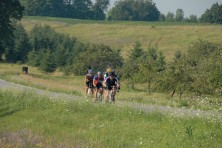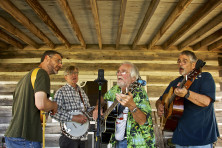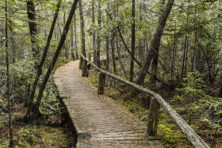History of Ridges Road
- Share
- Tweet
- Pin
- Share
Two years ago, the Harbor Ridges Association asked Leann Despotes, president of the Baileys Harbor Historical Society, if someone in the organization could prepare a 20-minute program on the history of Ridges Road for their spring breakfast. Despotes volunteered, but wondered if she could find enough material to fill 20 minutes.
As she began to do research, she discovered that the problem would be limiting the presentation to that time frame.

The program she developed, with additions, was presented recently for the historical society’s first meeting of 2015. It revived pleasant memories for longtime residents and informed those who’ve lived in the area for only a few decades of the good times they missed.
Baileys Harbor’s Lighthouses
Alanson Sweet, one of the signers of the charter to form the city of Chicago and the owner of the Gazelle, the schooner Captain Justice Bailey brought safely into harbor in 1848, saw business possibilities in the abundant timber and stone in the area. He immediately purchased two lots (although there’s some question about the validity of his title), and got the legislature to establish Door County with Baileys Harbor as the county seat (he proposed changing the name to Gibraltar, but that didn’t stick) and contracted with the federal government to build in 1851 what we now call the “bird cage” light at the entrance to the harbor.
Unfortunately, the lighthouse was placed incorrectly, contributing to many of the shipwrecks for which Baileys Harbor became known. It was replaced in 1869 by the Cana Island Lighthouse and the Upper and Lower Range Lights, now part of The Ridges Sanctuary. The bird cage light was sold in 1926 to William Mahler, who paid taxes of $9.84 the following year. It has been privately owned ever since, although for much of the last century it was a popular site for picnics – and for shooting out the windows in the structure.
Natural Beauty
Thomas Toft came to Wisconsin in 1863 from Denmark and spent time as a farmer in Minnesota. Eight years later he made his way to Door County and a job as foreman for the Buckley and Wing Stone Company. When the company went bankrupt, the owners left town owing the workers. Toft acquired some of the land from the company in lieu of owed wages and purchased more at a sheriff’s sale. He was adamant about not cutting natural growth trees, at a time when most landowners were clearing their land for farming.
In 1892, Toft purchased for $400 the large Miles Carrington home in Baileys Harbor. In 1900 his oldest son, William, bought the Joel Carrington house next door (now the site of the Baileys Harbor Visitors Center and Historical Society). Along with Toft Point, these would be the homes of Emma Toft, who was to become Wisconsin’s first lady of conservation.
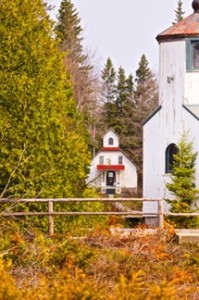
In 1967, the land Toft, and later Emma, protected for so long, was sold to The Nature Conservancy, with life tenancy given to Emma. Today Toft Point is owned by the Wisconsin Chapter of the Nature Conservancy and the University of Wisconsin-Green Bay. The site is recognized by the National Park Service as a National Natural Landmark and is a state natural area. Thirty years earlier, The Ridges Sanctuary had been formed, with the support of Emma Toft and others, after the Door County Park Board had tried to turn the land into a trailer park.
Albert Fuller, curator of botany at the Milwaukee Public Museum, spent a great deal of time in the mid-1930s, identifying rare flowers in what became The Ridges. Years later, his young assistant, Chester Cook, contributed a major gift to the building of the Cook-Albert Fuller Center, the Ridges’ new home in Baileys Harbor.
The Lifesaving/Coast Guard Station
The Lifesaving/Coast Guard Station, established in 1896 on what was then called Station Road (later Ridges) was a major part of life in Baileys Harbor until 1948, when it was closed “because of inadequate lake traffic.” It was manned by a captain and six “surf men,” each of whom had a specific duty. Rope had to be flawlessly packed into boxes to shoot from a small cannon called a Lyle gun, so that it wouldn’t tangle as they went to the aid of a ship in peril. Their boats were on rollers, because it was sometimes necessary to save time by pulling them over land to launch, rather than rowing across the lake. Local men, including those from the Anclam, Hickey and Levanger families, were favored for hire, because they knew the lake and the weather. In 1915, lifesaving stations were merged with the Revenue Cutter Service (that had been established in 1790 upon the recommendation of Secretary of the Treasury Alexander Hamilton to serve as an armed customs enforcement service) to create the Coast Guard. This made the men eligible for retirement pensions. An audience member recalled that as a boy he saw Coast Guardsmen patrolling the shore with M1 rifles.
The Fishing Industry
Commercial fishing has been a great tradition in Baileys Harbor. There are stories that fishermen used to return after a day on the water “waist deep in fish.” One of the first giants in the business was Cliff Wenninger, who came from Algoma in 1931 and established his business on part of the Coast Guard land. An inventive man, he built tracks to facilitate hauling huge boxes of fish to the shed, where they were dumped through a window onto cleaning tables. He also built crates and barrels to ship the catch. Despotes’ mother, who owned the Taste & Tattle Restaurant in Baileys Harbor, used to make a daily trip to Wenninger’s for fresh trout. A member of the audience said that local fish boils originated at the parties Wenninger held for his workers. He continued in business until 1974. Members of the audience shared their memories of such delicacies as whitefish livers, which summer people in their big cars lined up to buy for $5 a quart. A man in the audience said that years ago he used to catch “barrels of perch” off a local dock.
Hickey Brothers Fisheries on Ridges Road, established in 1965, is now the major commercial fishery in the area and an international corporation. They also contract with the National Park Service to help rid lakes in the parks of invasive fish.
Vacation Spots/Resorts
One of the early attempts to make Baileys Harbor a site for vacation homes was the North Point Reserve, organized in January 1923 by a group of businessmen from Sturgeon Bay, who advertised 50’ x 300’ lots on Ridges Road. Among the “amenities” they cited were phone service available at the nearby Coast Guard Station and “mail delivered to a convenient location” (probably also the Coast Guard Station). Land was also set aside for hunting by the new owners. The area became known as Lighthouse Point Reserve.
In the 1930s, during the height of the depression, camping in travel trailers was all the rage. Popular Mechanics printed directions for building them, and some people just improvised by cutting the back out of their Model T. (This was the era when the County Park Board thought a trailer park on the land that is now The Ridges Sanctuary would be a fine idea.)
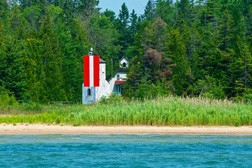
After the Coast Guard Station closed, the land was given to the County Park Department, and in about 1950 a bathing beach and bathhouse were established at Ridges County Park. Despotes recalled that there was a concession stand and that it was exciting to change clothes in the bathhouse, even when it had fallen into disrepair and was probably more dangerous than parents realized.
In 1935, Baileys Harbor summer residents, Jac and George Schmitz, established the popular summer resort, Schmitz Gazebos, located where the Yacht Club is today. In the 1930s, despite the Depression, tourism became popular and easier with the ownership of individual automobiles, and the Schmitz brothers took advantage of this, buying a lot of the land that had belonged to the Coast Guard Station. Jac Schmitz and town chairman Clarence Mann were instrumental in getting the road cut to Schmitz Gazebos, the Coast Guard Station, Wenniger’s and Alfred Anclam’s fishery. Previous to this, one had to negotiate a muddy, rocky path to town or walk along the shore.
The little red-roofed cottages were the closed-in “gazebos” with views of Lake Michigan. The resort, that could house 45 guests, also included a fine dining room and a cocktail lounge. Jac’s niece, Irene, had a significant hand in managing the resort. In the 1950s, the cocktail bar was especially popular at night because one could look out onto the lit patio and see the local wildlife come to retrieve scraps that were put out from the kitchen. The small animals became very comfortable with the situation and provided evening entertainment for the lounge patrons. The resort was active until 1965. Beginning with the opening of this resort, the Door County Advocate started to carry an East Baileys Harbor column with personal items about the comings and goings of guests at the gazebos.
Despotes shared items from an old menu: scallops, $2.75; lobster tail, $3.95; king crab, $3.25. A member of the audience who once worked there said he had to stay late one night to close because Paul Hornung, a Hall of Fame running back for the Packers, was in the bar and refused to leave.
After the last Schmitz brother died, the land was sold to Aribert Wild, who built the Baileys Harbor Yacht Club in 1969. Its incredible dining room, that for many years required formal dress, attracted owners of 85’ boats, like Ray Kroc, who built McDonald’s into the most successful fast food operation in the world. He used to helicopter in with his pilot/bodyguard. Sing-alongs with Lois Brann in the piano bar were another highlight. Later, when Maureen Kelly took over, as many as 75 boats anchored offshore on weekends to take in the magnificent Sunday brunches. The clubhouse burned in 1993, and the new yacht club, built away from the water, features duplexes.
The presentation also mentioned other Ridges Road institutions like the Sandpiper Restaurant that occupied the space where the new home of The Ridges Sanctuary now stands, and the Sands Motel across the road, now the Harbor Sands Condominiums. Change has been a constant through the decades in Baileys Harbor, but the historical society is keeping the memories alive.

